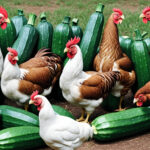Raising chickens isn’t just about the joys of farm-fresh eggs and the gentle clucking as your feathered friends forage—it’s a journey rich with color and surprise. For those drawn to the pastel perfect hues of robin’s eggs, the Prairie Bluebell Egger emerges as a pure delight. This relatively modern breed takes egg aesthetics to new heights with its vibrant blue eggs. In this comprehensive guide, we’ll explore the secrets of raising Prairie Bluebell Eggers to enhance your table with a daily masterpiece of edible art.
The rise of backyard poultry has ignited interest in chicken breeds that offer more than just sustenance; they offer spectacle. Among these, the Prairie Bluebell Egger stands out, not just for the striking appearance of their eggs but for their docile temperament and hardy nature. Whether you’re a seasoned chicken keeper or considering your first brood, the revelations strewn throughout this piece aren’t to be missed. Come along as we delve into the world of these enchanting birds.
Understanding Prairie Bluebell Eggers
The Prairie Bluebell Egger isn’t a breed steeped in ancient history. Instead, it’s the result of selective breeding aimed at capturing both the visual and culinary allure of blue eggs, paired with a robust and friendly chicken.
Origins of Blue Egg Layers
Prairie Bluebell Eggers can trace their lineage back to breeds known for their blue egg-laying prowess, such as the Araucana and the Ameraucana. However, Prairie Bluebell Eggers are a distinct type bred for vigor and egg production consistency.
Characteristics and Temperament
These birds are recognized for their striking appearance—ranging in color from bluish lavenders to grays and even shades of brown—and their friendly demeanor. Here’s what to expect:
- Appearance: Sleek feathering with a palette of cool tones.
- Temperament: Gentle and amicable, they are suitable for families.
- Egg Production: Prolific layers, averaging about 4 to 5 eggs per week.
Setting up the Perfect Habitat for Prairie Bluebell Eggers
A suitable home is crucial for the wellness of your chickens, and Prairie Bluebell Eggers are no exception. Their habitat should combine comfort, security, and the necessary amenities for a fulfilling life.
Coop Considerations
- Size: Ample space is key. Aim for at least 4 square feet per bird inside the coop.
- Ventilation: Keep the air fresh to avoid respiratory issues.
- Nesting Boxes: Provide a serene, darkened space for laying those coveted blue eggs.
Outdoor Access
Access to the outdoors is essential for Prairie Bluebell Eggers to exhibit natural behaviors. A secured run affords protection while allowing for essential sunlight and foraging opportunities.
Nutrition: Fueling the Blue Egg Phenomenon
Just as an artist needs quality paints, Prairie Bluebell Eggers require a high-quality diet to produce their stunning eggs.
Layer Feed and Supplements
A balanced layer feed rich in protein and calcium will ensure consistent egg production. Consider these additions:
- Calcium: Offer oyster shell supplements for strong eggshells.
- Greens and Protein: Encourage natural foraging or supplement with greens and insects.
Health and Wellness Practices
The vibrance of Prairie Bluebell Eggers’ eggs is a telltale sign of their health. Employ proactive healthcare measures to maintain your flock’s happiness and productivity.
Regular Health Checks
Conduct routine examinations to catch issues like mites or signs of illness early. Keep an eye out for symptoms such as lethargy or a drop in egg production.
Vaccinations and Parasite Control
Stay up to date with vaccinations and employ regular parasite control to safeguard against common poultry afflictions.
Breeding Prairie Bluebell Eggers for Egg Color Consistency
If you’re looking to maintain or even improve the beguiling blue of your flock’s eggs, consider a selective breeding program.
Understanding Genetics
It’s beneficial to grasp the basics of chicken genetics, particularly the genes responsible for blue egg coloration, to make informed breeding choices.
Selective Mating
Choose your breeding stock with care, prioritizing birds that consistently produce eggs with the most vivid blue tones.
The Daily Care of Prairie Bluebell Eggers
Your commitment to daily care is crucial for the well-being of your flock and the quality of their eggs.
Feeding and Watering Routines
Ensure they have constant access to fresh food and clean water. An automated feeder and waterer can help maintain a routine.
Egg Collection
Timely egg collection prevents accidental damage and ensures freshness. Collect eggs daily for the best quality.
Overcoming Challenges with Prairie Bluebell Eggers
Even in the most idyllic settings, challenges may arise. Be prepared to address common hurdles such as:
- Predator Management: Secure the coop and employ deterrents to keep predators at bay.
- Extreme Weather: Provide adequate shelter and regulate coop temperatures during extreme heat or cold spells.
Enjoying Prairie Bluebell Eggers’ Blue Eggs in Your Kitchen
Once you’ve mastered raising these impressive layers, they’ll reward you with a bounty of eggs. Here are inventive ways to celebrate their unique contributions to your kitchen:
Creative Recipes that Highlight Blue Eggs
- Pastel Deviled Eggs: Utilize the blue shells as a natural dye for a stunning appetizer.
- Egg-cellent Baking: Showcase the vibrant yolks in rich baked goods.
The Nutritional Benefits of Eggs
Eggs from Prairie Bluebell Eggers are not only beautiful but nutritious. They offer a significant source of protein and essential vitamins.
Frequently Asked Questions about Prairie Bluebell Eggers
Let’s address some of the common queries related to these captivating chickens:
How many years will my Prairie Bluebell Egger lay blue eggs?
With proper care, they can lay for 4-6 years, though peak production is typically the first two years.
Can the blue eggshell color fade over time?
Factors such as diet and health can influence vibrancy, but genetics are the main determinant of shell color.
Are blue eggs different in taste or nutrition from white or brown eggs?
There’s no significant difference—shell color does not affect taste or nutritional content.
In Conclusion: The Rewarding World of Blue Eggs
Raising Prairie Bluebell Eggers grants not only the tangible delight of blue eggs but the intangible rewards of chicken keeping. It’s an investment in natural beauty, sustainable living, and culinary excitement. Embrace these secrets, and relish the daily wonders of your very own azure egg bounty.
Embracing the world of Prairie Bluebell Eggers is an act of culinary and aesthetic expression. As we conclude this extensive guide, you’re now equipped with the knowledge to weave the rich tapestry of azure eggs into the fabric of your homestead. Whether basking in the pale blue orb’s morning welcome or marveling at the dinner table’s delightful surprise, you are on the threshold of a journey dyed in the most splendid shades of blue.






